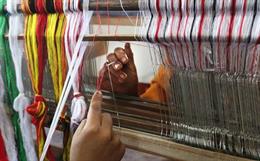Introduction
Wrightiatinctoria R. Br. fibre is used for design and development of non-woven medicalapparel. Wrightia tinctoria is also known as the psoriasis curative fibreobtained from dead seed of Wrightia tinctoria plant. Thefibre has excellent medicinal properties and protects from skin diseases andother common ailments.
Southern part of India has Wrightia tinctoria (AppocynaceaeFamily) that belong to genus Wrightia. It contains many important chemicalssuch as triterpenoid with cycloartenone, cyloeucalenol etc. It is pestresistant and also fights against drought. The wrightia tinctoria dead seed fibrecontent has been identified by bio chemical methods.
Tensileand elongation properties of fibres are influenced by the internal structure ofthe fibres. Individual fibres of a given length and under specified tension aresubjected to vibration at resonance frequency. The linear density is determinedfrom the conditions of the resonance state i.e. the resonance frequency, thelength of the fibre and the tensioning force. The morphology of wrightia tinctoria was examined using scanningelectron microscopic. Swelling anddissolution of fibre in non-derivating solvents and the description of theachieved dissolution state are important task
WrightiaTinctoria
Wrightiatinctoria R. Br., (Apocynaceae) (
Taxonomy of Wrightia Tinctoria
|
Family |
Apocynaceae |
|
Sub Family |
|
|
Tribe |
|
|
Genus |
Wrightia |
|
Species |
Tinctoria |
|
Order |
Gentianales |
|
Season |
Summer |
|
Colour of Flower |
White |
Table 1: Taxonomy of Wrightia Tinctoria
Traditional uses of W.Tinctoria
Fresh leaves of W.Tinctoria are pungent and when crushed can be used for tooth ache, snakebite and psoriasis. Many of the medicinal properties are to be substantiated by clinical trials in humans. Table 2 summarizes ethno medicinal uses reported for W. tinctoria.
|
Plant part |
Method of preparation |
Use |
|
Leaf |
Paste |
Skin diseases; external and internal application |
|
Paste |
Toothache and swelling gums |
|
|
Pounded leaves mixed with coconut oil |
Eczema, psoriasis and other skin diseases |
|
|
Unspecified |
Skin disease, wound healing |
|
|
Juice mixed with lime and turmeric powder |
Swellings |
|
|
Infusion from coconut oil |
Chronic wounds (veterinary medicine) |
|
|
Paste with Santalum album and Allium cepa |
Chronic wounds (veterinary medicine) |
|
|
Juice |
Jaundice |
|
|
Oil obtained from the paste of leaves of W. tinctoria and Azadirachta indica |
Eczema |
|
|
Half a teaspoon of dried leaf powder |
Respiratory ailments |
|
|
Bark |
Stem bark crushed with those of Ailanthus excelsa, paste applied daily once for 3 |
Boils, wounds |
|
Powdered and mixed with coconut oil |
Wounds |
|
|
Unspecified |
Galactogogue, abdominal pain |
|
|
Unspecified |
Antipyretic |
|
|
|
Unspecified |
Cure skin diseases, wounds |
|
Unspecified |
Antidote for snake poison |
|
|
Decoction |
Antidysenteric, antidiarrhoeal and antihaemorrhagic agent |
|
|
Paste |
Skin diseases, ringworm and in leprosy |
|
|
Infusion |
Stomach disorder |
|
|
Stem |
Unspecified |
Toothbrush |
|
Decoction |
Cure stomach disorder |
|
|
Latex |
Unspecified |
Skin disease, wound healing |
|
Root |
Decoction |
Epilepsy |
|
Unspecified |
Laxative |
|
|
Decoction |
Cure stomach disorder |
|
|
Whole plant |
Unspecified |
Antioxidant, Antinociceptive |
|
Seed |
Powdered and mixed with coconut oil |
Wounds |
|
Unspecified |
Piles, worm infestation and pain |
|
|
Juice |
Indigestion |
|
|
Unspecified |
Decoction |
Wounds |
Table 2: Ethno medicinal uses of W. tinctoria
Development of non-woven medical apparel
• Methodology
Fibre collection
The naturally dried seed pods are collected from the plant which is allowed to decay by exposing in sunlight or otherwise break the seed pods manually by applying external force. Once the seed gets separated from the seed pods then the fibre is separated from the seeds through plugging process.
Estimation of Fibre Content
Content of Fibre table
|
Contents |
% |
|
Cellulose |
42 |
|
Hemicelluloses |
23 |
|
Lignin |
14 |
Microscopic Appearance
Nonwoven (formed) fabrics
To differentiate them from felt, other nonwovens are defined by the 'American Society for Testing and Materials' as fabrics constructed from fibres held together by mechanical, chemical and thermal bonding. The history of nonwovens began in the 1930s when a few textile firms began experimenting with cotton waste fibres.
Significant commercial production began during World War II. The development of manmade fibres and bonding agents gave added impetus to this segment of the textile industry. In the course of this development, cognizance was taken of the detractive and even negative connotation of the term "nonwovens". Consequently, reference to these materials as formed fabrics is also used.
Methods of manufacture
The processing and manufacturing of nonwoven fabrics vary with the fibres, methods of laying the fibres, and the bonding agents used. The fibres include cotton, wool, rayon, acetate, nylon, polyester, acrylic, modacrylic, polypropylene, and polyethylene. A combination of fibres can be employed. The staple, which is usually not waste, ranges from about 1/12 to 6 inches (2- 150 mm) in length. Generally, the manmade fibres are 1. 5 to 6 denier; however, for some specialized surgical and industrial purposes, the range may be from about 5 microdenier to 10 denier, depending upon the porosity and weight desired. The fibres are processed through a series of opening, conditioning, and blending operations. Layers of webs of fibre are then formed. Adhesion of the fibres is accomplished by fibre friction, heat, addition of an appropriate resin, latex or other bonding agent.
Finishing of nonwoven fabrics: Finishing techniques for nonwoven fabrics are limited. Dyeing is usually done after the fabric has been formed. They may be calendared for smoothness or embossed for textured effects. They may also be printed or flocked. Softness may be added to improve the hand.
Testing: The developed medical apparel will be tested for various physical, mechanical and anti-microbial testing. Skin irritation test and other related test are done using standard test equipments.
Conclusion
The results from the above test conducted on the developed fabric will be analyzed and reported. The developed fabric will be of immense use to the society.
References:
2. Subramanian K, Senthil kumar P, Jeyapal P, and Venkatesh N, Characterization of lingo-cellulosic seed fibre from Wrightia tinctoria plant for textile application-an exploratory investigation, Eurpolym J, 2005, 41 (4), 853-861.
3. Ayurveda-foryou.com
4. S.Sadasivam, A. Manickam, Biochemical Methods (Third Edition) published in New Age International (P) Limited.
5. Technical details of Digital Projection Microscope Paramount.
6. Farzad Hosseinali, Investigation on the Tensile Properties of Individual Cotton (Gossypium hirsutum L.) Fibres, CROP SCIENCE; August, 2012.
7. Textile fibres - Determination of linear density Gravimetric method and vibroscope method, COMESA HARMONISED COMESA/FDHS STANDARD, 268: 2006
8. C. Cuissinat, P. Navard and T. Heinze, Carbohyd. Polym., 72, 590 (2008)
9. Colom X. and Carillo F. 2002, Crystallinity changes in lyocell and viscose-type fibres by caustic treatment, European Polymer Journal, 38 (11), 2225-2230.
10. Crawshaw J., Bras W., Mant G.R. and Cameron R.E. 2002, Simultaneous SAXS and WAXS investigations of changes in native cellulose fibre microstructure on Swelling in aqueous sodium hydroxide, J. Appl. Polym. Sci., 83 (6), 1209-1218.
11. Lenz J., Schurz J. and Eichinger D. 1994, Properties and structure of lyocell and Viscose-type fibres in swollen state, Lenzinger Berichte, 9, 19-25.
12. Anonymous. The wealth of India. New Delhi: Publication and Information Directorate, CSIR; 1976, p. 588-590.
13. Nadkarni KM. Indian materia medica. Bombay: Popular Prakashan; 1976, p. 1296.
14. Joshi SG. Medicinal plants. New Delhi: Oxford and IBH publishing Co Pvt Ltd.; 2000, p. 51-52.
15. Ambasta SP. The useful plants of India. New Delhi: Publication and Information Directorate, CSIR; 1986.
16. Drury CH. Ayurvedic useful plants of India. Delhi: Asiatic Publishing House; 2006, p. 446-447.
17. Pramila MS. Ayurvedic herbs: a clinical guide to the healing plants of traditional Indian medicine. New York: The Haworth Press Inc.; 2006, p. 209-211.
18. Akhtar H, Virmani OP, Popli LN, Misra LM, Gupta MM, Srivastava GN, et al. Dictionary of Indian medicinal plants. Lucknow: Central Institute of Medicinal and Aromatic Plants; 1992, p. 496.
19. Bhattacharjee SP. Handbook of medicinal plants. Jaipur: Pointer Publishers; 2000, p. 60.
20. Chopra RN, Chopra IC, Handa KL, Kapur LD. Indigenous drugs of India. 2nd ed. Calcutta: M.N. Dhur and Sons; 1958, p. 345.
21. Ignacimuthu S, Ayyanar M, Sankarasivaraman K. Ethnobotanical study of medicinal plants used by paliyar tribals in Theni district of Tamil Nadu, India. Fitoterapia 2008; 79: 562-568.
22. Goli PP, Prasad GP, Sudarsanam G. Ethnomedical studies in Kailasagirikona forest range of Chittoor District, Andhra Pradesh. Anc Sci Life 2009; 29: 40-45.
23. Sugumaran M, Bharathi V, Hemachander R, Lakshmi M. Ethnomedicinal plants for indigestion in Uthiramerur taluk, Kancheepuram district, Tami Nadu, India. J Chem Pharm Res 2010; 2: 463-470.
About the author
Dr. G. Ramakrishnan is currently working as Senior Associate Professor in Department of Fashion Technology, and Coordinator of KCT-TIFAC CORE, Kumaraguru College of Technology, Coimbatore. He has 29 years of experience that includes industry and academics.
Acknowledgement
The authors express their sincere thanks to Management of Kumaraguru College of Technology, Coimbatore and Textile Research Centre, KCT-TIFAC-CORE in Textile Technology and Machinery, of Kumaraguru College of Technology, Coimbatore, India for permitting to process all the samples in their advanced manufacturing laboratory.







